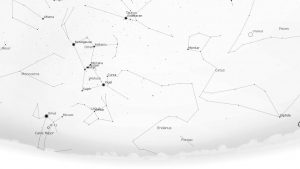| Meaning: | The River | Print out the star map from Sky and Telescope
Things to look for:
Messier objects: Note: [x.x] indicates visual magnitude |
|
| Pronunciation: | air uh day’ nus | ||
| Associated Asterisms: | None | ||
| % of the sky: | 2.76 | ||
| Visible Stars: | 79 stars brighter than magnitude 5.5 |


You may have looked at Orion a thousand times and wondered at the brightness and composition of Betelgeuse and Rigel, but I suspect whilst looking at Rigel you didn’t notice the constellation nestling up to Orion from the Southwest. The border between the constellations is just to the right of Rigel and you’d be forgiven for thinking the stars in the area all belong to Orion. They don’t. Have a look at the star chart. There is another reason you might not be familiar with Eridanus, the River and that is because nearly half its southern extent is not visible from the UK, including it’s brightest star α Eri or Achernar. Achernar is the 9th brightest star in the sky and so familiar to antipodean observers. The second brightest in the constellation is observable from the UK and is β Eri or Cursa; it is the 124th brightest star in the sky. Best seen in November, the constellation hangs on through the Winter accompanying Orion. Another reason to know the constellation is that is big; 6th out of the modern 88 constellations.

To find the constellation, start at Rigel and the close bright star Cursa, β Eri. Follow the meander to the West towards Cetus before it dips South and the swings back East before plunging Southwest to ‘uncharted’ skies. In the UK, we lose it just at the Southwest plunge point.

It is an old constellation dating back to the 2nd century and Ptolemy’s list of 48. There are various theories on the derivation of the name. Perhaps it takes its name from the Babylonian constellation known as the Star of Eridu. Eridu was an ancient city in the extreme south of Babylonia; situated in the marshy regions it was held sacred to the god Enki-Ea who ruled the cosmic domain of the Abyss – a mythical conception of the fresh-water reservoir below the Earth’s surface. Or perhaps Eridanus is connected to the myth of Phaethon, who took over the reins of his father Helios’ sky chariot (i.e., the Sun), but didn’t have the strength to control it and so veered wildly in different directions, scorching both Earth and Heaven; the constellation marks his chaotic route. Zeus was unimpressed and killed Phaethon with a thunderbolt. A final interpretation is perhaps the simplest. It looks like a meandering river and is associated with several rivers around the World (source: Wikipedia).

The constellation contains a fair smattering of NGC objects well worth a look at. The Witch Head Head Nebula NGC1909/IC2128 sits close to Rigel and is quite faint so best captured photographically where it’s strong blus colour shows up well. It is a reflection nebula.
NGC1535 or Cleopatra’s Eye or Eskimo’s Wife Nebula is a planetary nebula between Rigel and Zaurak (4/5 of the way between). It is mag 9.6.

